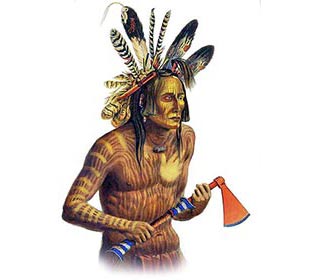The names of the North Dakota tribes included the Arapaho, Arikara, Cheyenne, Chippewa, Crow, Dakota, Hidatsa and Mandan (see above picture). The Arapaho, Cheyenne, Chippewa, Crow and the Dakota Sioux. North Dakota - Indian Territory
Indian Territory was a vast area of U.S. federal territory on the Great Plains reserved for Indians from the 1830s to the 1880s. In the 1870's the deliberate great slaughter of the northern bison herds began designed to prevent the Native Indians continuing the Great Plains lifestyle. Indian Territory eventually became the states of Kansas, Nebraska, and Oklahoma. By 1907, when Oklahoma was admitted as a state, Indian Territory ceased to exist. Fast Facts about the History of North Dakota Indians
The climate, land, history, environment and natural resources that were available to the indigenous Indian tribes in North Dakota resulted in the adoption of the Great Plains Indians culture. - Name of State: North Dakota
- Meaning of State name: Dakota is a tribal name of the Sioux meaning “Allies.”
- Geography, Environment and Characteristics of the State of North Dakota: Rolling plateau and Great Plains
- Culture adopted by North Dakota Indians: Great Plains Cultural Group
- Languages: Due to the number of migrant tribes in this area people spoke a variety of languages including Siouan, Algonquian, Caddoan, Uto-Aztecan and Athabaskan
- Way of Life (Lifestyle): Nomadic Hunters and farmers
- Types of housing, homes or shelters: Tepees were used by the nomadic hunters. The semi-nomadic tribes used tepees but also maintained permanent earth lodge villages situated along rivers, others built houses of grass. The farmers used Earth lodges
History Timeline of the North Dakota Indians
The Sioux, Assiniboine, Cheyenne, Mandan, Hidatsa, and Arikara were the first Indian inhabitants. The Chippewa (or Ojibway), Cree, Blackfeet, and Crow moved to the area in the 1800's. - 10,000 B.C. : Paleo-Indian Era (Stone Age culture) the earliest human inhabitants of America who lived in caves and were Nomadic hunters of large game including the Great Mammoth and giant bison.
- 7000 BC: Archaic Period in which people built basic shelters and made stone weapons and stone tools
- 2500 BC: Gulf Formational Period with development of ceramics and pottery
- 1000 AD: Woodland Period including the Hopewell cultures established along rivers in the Northeastern and Midwestern United States which included trade exchange systems and burial systems
- 1682: Area claimed by René-Robert Cavelier, Sieur de La Salle (1643-1687) for France
- 1775: 1775 - 1783 - The American Revolution.
- 1776: July 4, 1776 - United States Declaration of Independence 1803: The United States bought the Louisiana Territory from France for 15 million dollars for the land
- 1812: 1812 - 1815: The War of 1812 between U.S. and Great Britain, ended in a stalemate but confirmed America's Independence
- 1823: Arikara War - Campaign against Arikara Indians, upper Missouri River, Dakota Territory
- 1830: Indian Removal Act
- 1832: Department of Indian Affairs established
- 1837: Smallpox virtually wipes out the Mandan people at Fort Clark
- 1862: Sioux Indian war in Minnesota and Dakota. The Sioux killed upwards of 1,000 settlers in Minnesota then fled to Dakota territory pursued by 5000 US Cavalry soldiers
- 1861: 1861 - 1865: The American Civil War.
- 1862: U.S. Congress passes Homestead Act opening the Great Plains to settlers
- 1863: 1863 - 1865 Major military expeditions searched rebellious Indians
- 1865: The surrender of Robert E. Lee on April 9 1865 signalled the end of the Confederacy
- 1870's: The deliberate great slaughter of the northern bison herds to prevent the Native Indians continuing the Great Plains lifestyle
- 1876: 1876 - Battle of Little Bighorn, Montana. Sioux and Cheyenne defeated General Custer and the Seventh Cavalry.
- 1878: 1878-1879 -- Campaign against Cheyenne Indians in Dakota (Territory) and Montana
- 1887: Dawes General Allotment Act passed by Congress leads to the break up of the large Indian Reservations and the sale of Indian lands to white settlers
- 1890: Battle of Wounded Knee - Ghost Dance War (1890–1891) aka Pine Ridge Campaign. The Wounded Knee Massacre in South Dakota followed the killing of Chief Sitting Bull. Chief Big Foot led the last band of Lakota Sioux and were massacred by the US Army at Wounded Knee Creek.
- 1969: All Indians declared citizens of U.S.
- 1979: American Indian Religious Freedom Act was passed
|
